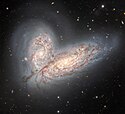NGC 4567/8
| Galaxie NGC 4567/8 / KPG 347 / VV 219 | |
|---|---|
 | |
| NGC 4567 oben links, NGC 4568 mittig, Gemini-Observatorium | |
| AladinLite | |
| Sternbild | Jungfrau |
| Position Äquinoktium: J2000.0, Epoche: J2000.0 | |
| Rektaszension | 12h 36m 33,5s[1][2] |
| Deklination | +11° 15.0′ [1][2] |
| Erscheinungsbild | |
| Morphologischer Typ | NGC 4567: SA(rs)bc HII pec NGC 4568: SA(rs)bc HII[3][4] |
| Helligkeit (visuell) | NGC 4567: 11,3 mag NGC 4568: 10,9 mag[3][4] |
| Helligkeit (B-Band) | NGC 4567: 12,1 mag NGC 4568: 11,7 mag[3][4] |
| Winkelausdehnung | NGC 4567:3′,1 × 2′,2 NGC 4568:4′,6 × 2′,2[3][4] |
| Positionswinkel | NGC 4567: 85° NGC 4568: 23°[3][4] |
| Flächenhelligkeit | NGC 4567: 13,2 mag/arcmin² NGC 4568: 13,3 mag/arcmin²[3][4] |
| Physikalische Daten | |
| Zugehörigkeit | Virgo-Galaxienhaufen LGG 285[1] |
| Rotverschiebung | 0,007495 ± 0,000005[1] |
| Radialgeschwindigkeit | (2247 ± 1) km/s[1] |
| Hubbledistanz H0 = 73 km/(s • Mpc) | (98 ± 7) · 106 Lj (30,0 ± 2,1) Mpc [1] |
| Durchmesser | 105.000/145.000 Lj |
| Geschichte | |
| Entdeckung | Wilhelm Herschel |
| Entdeckungsdatum | 15. März 1784 |
| Katalogbezeichnungen | |
| NGC 4567 • NGC 4568 • UGC 7777/7776 • PGC 42064/42069 • CGCG 070-189/188 • MCG +02-32-151/152 • 2MASX J12363270+1115283/J12363429+1114190 • VCC 1673 • VCC 1676 • VV 219 • GC 3108/3109 • H IV 8 • H IV 9 • h 1358/1363/1359/1363 • Holm 427 • KGP 347 | |
NGC 4567/8 oder KPG 347 oder VV 219 sind zwei Spiralgalaxien im Virgo-Cluster im Sternbild Virgo. Die Galaxien werden auch "The Butterfly Galaxies" oder "The Siamese Twins" genannt (letzterer Name wird laut NASA wegen des diskriminatorischen Inhalts nicht mehr benutzt).[5] Es wird angenommen, dass sich das Paar in einem frühen Stadium der Interaktion befindet.
Beobachtungsgeschichte
Das Objekt wurde am 15. März 1784 vom britischen Astronomen William Herschel entdeckt.[6] Am 20. Januar 1990 wurde von Saul Perlmutter und Carl Pennypacker in NGC 4568 die Supernova SN 1990B vom Typ Ib entdeckt. Am 10. Juni 2004 wurde im Rahmen des Lick Observatory Supernova Survey in NGC 4568 mit SN 2004cc eine Supernova vom Typ Ic entdeckt.[7][8] Am 31. März 2020 entdeckte die Zwicky Transient Facility die Supernova SN 2020fqv in NGC 4568.[9]
Literatur
- Smith et al.: "The Herschel Virgo Cluster Survey. IV. Resolved dust analysis of spiral galaxies"; Astronomy and Astrophysics 518
- Xu et al.: "Mapping Infrared Enhancements in Closely Interacting Spiral-Spiral Pairs. I. ISO CAM and ISO SWS Observations"; The Astrophysical Journal 541 (2), S. 644–659
- König, Michael & Binnewies, Stefan (2019): Bildatlas der Galaxien: Die Astrophysik hinter den Astrofotografien, Stuttgart: Kosmos, S. 251
- Kaneko et al.: "Molecular Gas in the Early Stage of Interacting Galaxies: The NGC 4567/8 Pair"; ASP Conference Series Vol. 423
- Iono et al.: "Atomic and Molecular Gas in Colliding Galaxy Systems. I. The Data"; The Astrophysical Journal Supplement Series 158 (1), S. 1–37
Weblinks
Einzelnachweise
- ↑ a b c d NASA/IPAC EXTRAGALACTIC DATABASE NGC 4567
- ↑ NASA/IPAC EXTRAGALACTIC DATABASE NGC 4568
- ↑ a b c d e f SEDS: NGC 4567
- ↑ a b c d e f SEDS: NGC 4568
- ↑ Jon Haworth: NASA drops 'insensitive' celestial nicknames in effort to address systemic discrimination. In: ABC News. 9. August 2020, abgerufen am 10. August 2020 (englisch).
- ↑ Seligman
- ↑ Kopernik Observatory & Science Education Center: "Spiral Galaxies NGC 4568 and NGC 4567"
- ↑ CfA
- ↑ SN 2020fqv. Transient Name Server
Auf dieser Seite verwendete Medien
Autor/Urheber:
Credit:
International Gemini Observatory/NOIRLab/NSF/AURA
Image processing: T.A. Rector (University of Alaska Anchorage/NSF's NOIRLab), J. Miller (Gemini Observatory/NSF's NOIRLab), M. Zamani (NSF’s NOIRLab) & D. de Martin (NSF’s NOIRLab), Lizenz: CC BY 4.0The merging galaxy pair NGC 4568 and NGC 4567
This image from the Gemini North telescope in Hawai‘i reveals a pair of interacting spiral galaxies — NGC 4568 (bottom) and NGC 4567 (top) — as they begin to clash and merge. The galaxies will eventually form a single elliptical galaxy in around 500 million years.
Credit:
International Gemini Observatory/NOIRLab/NSF/AURA Image processing: T.A. Rector (University of Alaska Anchorage/NSF's NOIRLab), J. Miller (Gemini Observatory/NSF's NOIRLab), M. Zamani (NSF’s NOIRLab) & D. de Martin (NSF’s NOIRLab)
Coordinates Position (RA): 12 36 33.26 Position (Dec): 11° 14' 30.08" Field of view: 5.76 x 5.24 arcminutes Orientation: North is 89.0° left of vertical Colors & filters Band Wavelength Telescope Optical g 475 nm Gemini North GMOS-N Optical r 630 nm Gemini North GMOS-N Optical i 780 nm Gemini North GMOS-N Optical H-alpha 656 nm Gemini North GMOS-N.
